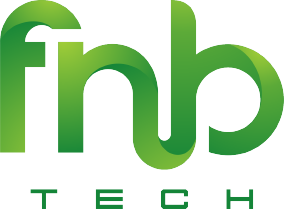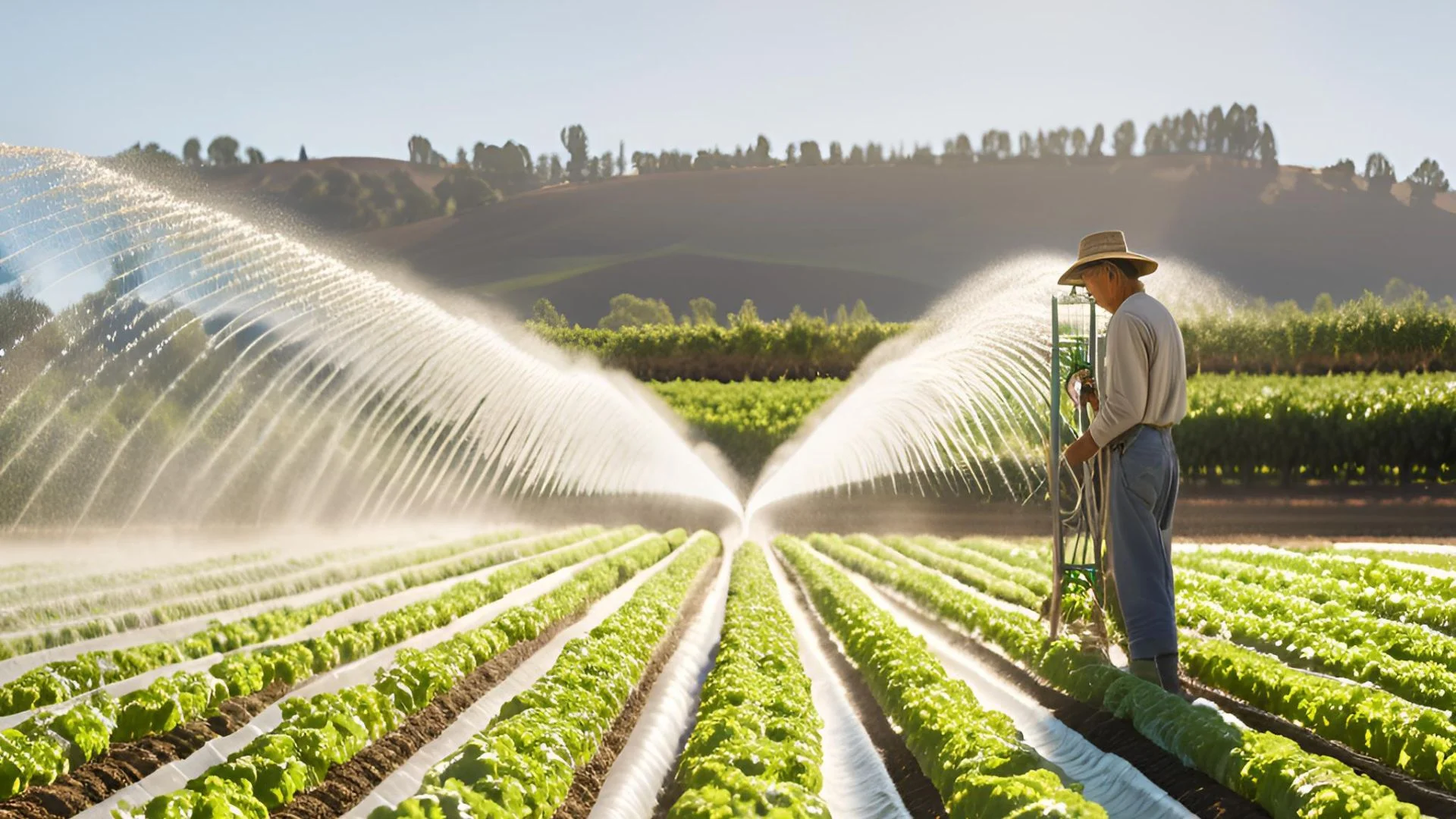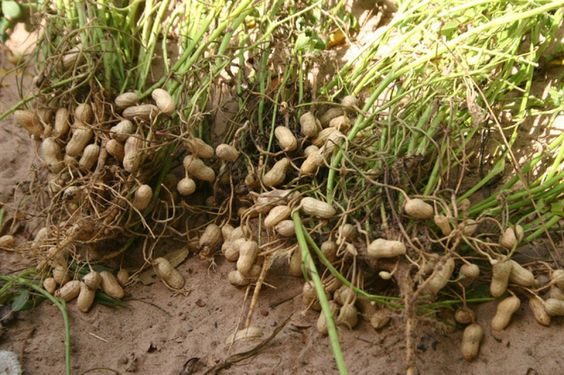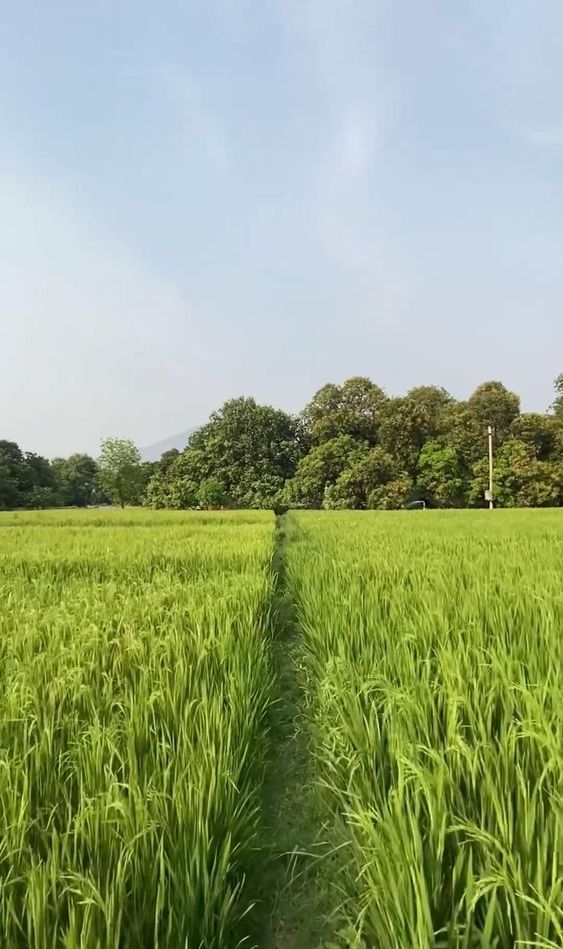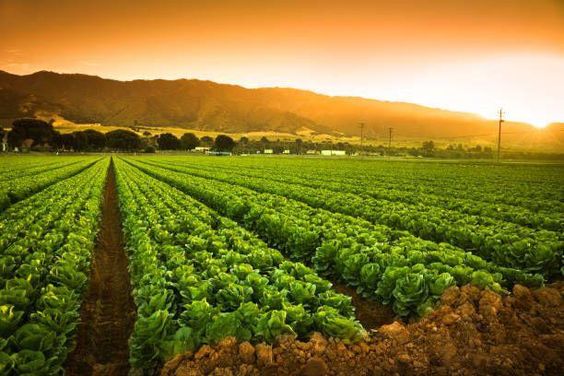The Importance of Sprinkler Irrigation
Efficient water management is a crucial aspect of modern agriculture. Farmers and agricultural experts continuously seek irrigation methods that optimize water use while ensuring crops receive adequate moisture. One of the most effective and widely adopted methods is sprinkler irrigation.
This system mimics natural rainfall by distributing water evenly across fields using a network of pipes, pumps, and sprinklers. It is commonly used in agriculture sprinkler irrigation, landscaping, and even golf courses due to its versatility and efficiency.
In this article, we will explore the fundamentals of sprinkler irrigation, its types, benefits, drawbacks, and components. We will also discuss how technology, such as farm irrigation sprinkler solutions, is improving modern farming practices.
Contents
- 1 What Is Sprinkler Irrigation?
- 2 The Difference Between Spray and Sprinkler Irrigation
- 3 Benefits of Sprinkler Irrigation
- 4 How Does Sprinkler Irrigation Work?
- 5 The Pros of a Sprinkler Irrigation
- 6 Components Required In Spray Irrigation System
- 7 Agritech From FnB Tech Indonesia to Ease Your Cultivating System
- 8 Conclusions
What Is Sprinkler Irrigation?
Sprinkler irrigation is a method of applying water to crops in a way that resembles natural rainfall. It involves a system of pumps, pipes, and nozzles that spray water into the air, allowing it to fall evenly onto the soil surface. This technique is widely used in agriculture sprinkler irrigation due to its efficiency in covering large areas and its ability to minimize water wastage.
The primary goal of a farm irrigation sprinkler system is to ensure that crops receive the right amount of water at the right time, enhancing growth and productivity. Compared to traditional surface irrigation methods, sprinkler systems offer better water distribution and reduce soil erosion.
Sprinkler irrigation is commonly used for:
- Large-scale commercial farming
- Small and medium-sized farms
- Lawns, parks, and golf courses
- Greenhouses and nurseries
- This irrigation method is particularly beneficial in regions where water resources are limited, as it optimizes water usage and reduces wastage.
The Difference Between Spray and Sprinkler Irrigation
Although sprinkler irrigation and spray irrigation may seem similar, they have distinct differences in design, application, and efficiency. Understanding these differences is essential for farmers and landscapers to choose the best smart irrigation system for their needs.
1. Sprinkler Irrigation
- Uses high-pressure pumps to spray water over a large area.
- Designed for smart agriculture irrigation, providing consistent moisture for crops.
- Can be adjusted to control the volume and direct ion of water distribution.
- Ideal for large-scale farm irrigation sprinkler systems.
2. Spray Irrigation
- Often used for lawns, gardens, and small-scale farming.
- Uses lower water pressure and delivers water in a finer mist compared to sprinkler irrigation.
- Typically designed for decorative landscaping rather than large-scale agricultural use.
Benefits of Sprinkler Irrigation
Implementing sprinkler irrigation in agricultural and farming systems offers numerous advantages. This method is widely used in agriculture sprinkler irrigation due to its ability to distribute water efficiently while conserving resources. Below are some key benefits:
1. Efficient Water Distribution
Sprinkler systems ensure uniform water distribution across the field, mimicking natural rainfall. This helps prevent overwatering or underwatering, leading to better crop health and yield.
2. Water Conservation
Compared to traditional flood irrigation, farm irrigation sprinkler systems use water more efficiently by reducing runoff and evaporation. Some modern sprinkler systems also feature sensors to regulate water usage based on soil moisture levels.
3. Suitable for Various Terrains
Unlike surface irrigation, which requires even land surfaces, sprinkler irrigation can be used on sloped or uneven terrain. This makes it ideal for hilly agricultural regions where water management is challenging.
4. Reduces Soil Erosion and Nutrient Loss
Flood irrigation can lead to soil erosion and leach essential nutrients. With sprinkler irrigation, water is applied gently, preventing excessive soil displacement and preserving nutrients crucial for plant growth.
5. Saves Labor and Time
Many agriculture sprinkler irrigation systems are automated, reducing the need for manual labor. Once installed, these systems require minimal supervision, allowing farmers to focus on other essential tasks.
6. Flexibility in Application
Sprinkler systems can be adjusted to suit different crop types, growth stages, and climate conditions. This adaptability makes them ideal for farms cultivating a variety of crops.
7. Enhances Crop Yield and Quality
By providing consistent moisture levels, sprinkler irrigation supports healthy plant growth, leading to higher yields and better crop quality.
With these benefits, farm irrigation sprinkler systems are an excellent choice for modern agriculture, helping farmers maximize efficiency while conserving resources.
How Does Sprinkler Irrigation Work?
Sprinkler irrigation operates by distributing water through a network of pipes, pumps, and sprinkler heads that spray water over a designated area. The system is designed to imitate natural rainfall, ensuring even moisture distribution across crops.
1. Water Source and Pumping System
The process begins with a water source, which could be a well, river, reservoir, or a water storage tank. A pump is used to generate the necessary pressure to push water through the system. The pump type depends on factors such as field size, water availability, and required pressure levels.
2. Main and Lateral Pipelines
Once pumped, water travels through main pipelines, which distribute it to lateral pipes connected to individual sprinkler heads. These pipes can be made of PVC, polyethylene, or metal, depending on durability requirements and budget.
3. Sprinkler Heads and Nozzles
At the end of the lateral pipes, sprinkler heads release water into the air, breaking it into fine droplets that fall onto crops. Different types of sprinkler heads exist, including:
- Rotary sprinklers – Used for large-scale farm irrigation sprinkler systems.
- Fixed spray sprinklers – Ideal for smaller areas like gardens or nurseries.
- Impact sprinklers – Common in agriculture sprinkler irrigation, providing strong and even water coverage.
4. Control Valves and Automation
Modern sprinkler irrigation systems are often equipped with control valves, timers, and moisture sensors. These features allow farmers to regulate water flow, schedule irrigation, and prevent overwatering. Some advanced systems use smart technology to adjust irrigation schedules based on real-time weather conditions.
5. Water Application and Drainage
Once water is applied to the crops, it is absorbed by the soil, nourishing the plants. Any excess water either drains naturally or is collected for reuse in agriculture sprinkler irrigation systems that prioritize water conservation.
By utilizing farm irrigation sprinkler technology, farmers can optimize water usage, reduce manual labor, and improve crop health, making it a sustainable choice for modern agriculture.
Types of Sprinkler Irrigation Systems
There are several types of sprinkler irrigation systems designed to suit different agricultural needs. The choice of system depends on factors such as field size, crop type, water availability, and budget. Below are the most common types of farm irrigation sprinkler systems:
1. Traditional Sprinkler System
This is the most common agriculture sprinkler irrigation system, consisting of fixed sprinkler heads mounted on pipes or poles. Water is distributed in a circular pattern, ensuring even coverage. These systems are often used for medium to large-scale farming.
2. Center Pivot Irrigation
- A rotating system with sprinklers mounted on a long arm that moves in a circular pattern.
- Ideal for large farms growing crops like corn, wheat, and soybeans.
- Offers automated operation, reducing labor and increasing efficiency.
3. Lateral Move (Linear) Irrigation
- Similar to center pivot but moves in a straight line instead of a circle.
- Requires more water supply and infrastructure but provides uniform irrigation.
- Commonly used in rectangular fields where circular pivot systems are not suitable.
4. Drip Sprinkler Irrigation
- A combination of sprinkler irrigation and drip irrigation.
- Water is sprayed in controlled amounts directly onto the soil near plant roots.
- Ideal for crops that require precise water application, such as vegetables and fruits.
5. Traveling Gun Sprinkler System
- Uses a high-pressure rotating sprinkler head mounted on a cart that moves across the field.
- Suitable for large fields and pastures.
- Requires significant water pressure but covers a wide area efficiently.
6. Micro-Sprinkler Irrigation
- A low-pressure system that delivers small amounts of water through fine nozzles.
- Best for orchards, vineyards, and greenhouses.
- Helps conserve water while keeping the soil moist.
7. Portable Sprinkler System
- Consists of moveable sprinkler pipes and heads that can be relocated based on crop needs.
- Suitable for small farms or fields with varying irrigation requirements.
- A cost-effective solution for farm irrigation sprinkler setups.
Choosing the right sprinkler irrigation system depends on the farm’s layout, water availability, and crop type. Agriculture sprinkler irrigation systems help farmers maximize efficiency while ensuring consistent crop hydration.
The Pros of a Sprinkler Irrigation
Sprinkler irrigation is one of the most widely used irrigation methods in modern agriculture due to its numerous advantages. Below are some key benefits of using a farm irrigation sprinkler system:
1. Efficient Water Use
Unlike traditional flood irrigation, sprinkler irrigation ensures even water distribution, reducing water wastage. This is especially beneficial in areas with limited water resources.
2. Suitable for Various Terrains
Unlike surface irrigation, which requires level land, agriculture sprinkler irrigation can be used on hilly, sloped, or uneven terrain without the risk of water runoff or soil erosion.
3. Saves Time and Labor
Many sprinkler irrigation systems are automated, reducing the need for manual labor. Farmers can schedule irrigation sessions using timers, allowing them to focus on other essential agricultural tasks.
4. Prevents Soil Erosion
Flood irrigation can wash away nutrients and erode topsoil, but sprinkler irrigation applies water gently, preventing soil displacement and preserving fertility.
5. Adaptability to Different Crops
Whether growing vegetables, grains, or fruits, farm irrigation sprinkler systems can be adjusted to meet the specific water needs of different crops, improving yield and quality.
6. Reduces Weed Growth
By controlling water application directly to plant roots, sprinkler irrigation limits excess moisture in non-cultivated areas, reducing weed germination and competition for nutrients.
7. Works with Fertigation Systems
Modern agriculture sprinkler irrigation systems allow farmers to apply fertilizers and pesticides through the irrigation system, ensuring uniform nutrient distribution and reducing waste.
8. Suitable for Large and Small Farms
From small-scale farming to large commercial operations, sprinkler irrigation systems can be customized to suit different farm sizes and irrigation needs.
These advantages make sprinkler irrigation a preferred choice for many farmers seeking an efficient and sustainable water management system.
The Cons of Sprinkler Irrigation
While sprinkler irrigation offers numerous benefits, it also has some drawbacks that farmers must consider before implementing the system. Here are the key disadvantages of using a farm irrigation sprinkler system:
1. High Initial Investment
Setting up a sprinkler irrigation system can be costly due to the need for pumps, pipes, sprinkler heads, and automation systems. The agriculture sprinkler irrigation setup cost depends on the farm size and system complexity.
2. Requires Regular Maintenance
To ensure efficient operation, sprinkler irrigation systems require routine maintenance, including:
- Cleaning nozzles to prevent clogging.
- Checking for leaks or pipe damage.
- Adjusting pressure settings to maintain uniform water distribution.
3. Water Loss Due to Evaporation and Wind Drift
Compared to drip irrigation, sprinkler irrigation can lead to water loss through evaporation and wind drift, especially in hot, windy climates. This makes it less efficient in arid regions where water conservation is crucial.
4. Uneven Water Distribution in Strong Winds
Sprinkler performance can be affected by strong winds, which may cause uneven water coverage, leading to dry spots or overwatered areas. Farmers in windy regions may need to adjust their irrigation schedules accordingly.
5. Requires a Reliable Water Supply
Farm irrigation sprinkler systems depend on a consistent and sufficient water source. In areas with low water availability, this system may not be the most practical solution.
6. Potential for Water Runoff and Soil Compaction
If not managed properly, excessive water application from sprinkler irrigation can cause surface runoff and soil compaction, reducing water infiltration and leading to inefficient water use.
7. Energy Consumption
Pressurized agriculture sprinkler irrigation systems require electricity or fuel-powered pumps, leading to increased energy costs. Farmers need to balance efficiency with energy consumption to maintain sustainability.
Despite these challenges, many farmers continue to use sprinkler irrigation by optimizing system settings, choosing the right sprinkler heads, and scheduling irrigation during low-wind conditions to maximize efficiency.
Components Required In Spray Irrigation System
A spray irrigation system consists of several essential components that work together to distribute water efficiently across a farm or agricultural field. Each component plays a crucial role in ensuring that water reaches the crops evenly and effectively. Below are the key components required in a spray irrigation system:
1. Water Source
The system begins with a reliable water source, which can be a well, river, pond, reservoir, or municipal water supply. The quality and availability of water directly impact the effectiveness of the agriculture sprinkler irrigation system.
2. Pumping Unit
A pump is essential to move water from the source to the irrigation system. Different types of pumps, such as centrifugal, submersible, or turbine pumps, can be used depending on the farm’s topography and water pressure requirements. The pump ensures that water flows at the right pressure for uniform distribution.
3. Pipes and Tubing
The farm irrigation sprinkler system requires a network of pipes to transport water from the pump to the sprinkler heads. These pipes can be made of PVC, polyethylene, or metal, depending on durability and cost considerations. The piping system typically consists of:
- Mainline pipes – Carry water from the pump to different field sections.
- Lateral pipes – Distribute water to the sprinkler heads.
4. Control Valves
Valves regulate water flow within the system, allowing farmers to control irrigation zones, pressure levels, and water distribution. They can be manual or automatic and are essential for optimizing water use.
5. Sprinkler Heads
Sprinkler heads are responsible for dispersing water into fine droplets over the crops. There are different types of sprinkler heads, including:
- Rotary Sprinklers – Ideal for large agricultural fields as they rotate and cover wide areas.
- Fixed Sprinklers – Best suited for smaller plots or gardens.
- Pop-up Sprinklers – Common in lawns and horticultural farms.
6. Filters and Pressure Regulators
Filters are used to remove debris and prevent clogging of the sprinklers. Meanwhile, pressure regulators ensure that water is distributed at the correct pressure, preventing damage to pipes and uneven watering.
7. Automation System (Optional)
Modern agriculture sprinkler irrigation systems may include automation, such as timers, sensors, and remote controls. These smart technologies help monitor water usage, optimize schedules, and reduce labor costs.
By integrating these components, a spray irrigation system ensures efficient water distribution, helping farmers maximize crop yield while conserving water.
Agritech From FnB Tech Indonesia to Ease Your Cultivating System
Efficiency and sustainability are essential in modern agriculture. FnB Tech Indonesia provides innovative agritech solutions to help farmers optimize their cultivation systems, including sprinkler irrigation technology that ensures better water management.
Smart Sprinkler Irrigation for Maximum Efficiency
FnB Tech Indonesia offers automated sprinkler irrigation systems with IoT-based controls. These systems allow farmers to:
- Automate irrigation schedules based on crop needs
- Monitor soil moisture in real time
- Reduce water waste and increase crop productivity
With this technology, water is distributed efficiently, minimizing waste and lowering operational costs in farm irrigation sprinkler systems.
Why Choose FnB Tech Indonesia?
- Precision Irrigation Technology – Ensures optimal water distribution for crops.
- Energy-Efficient Pumps – Reduces electricity consumption for agriculture sprinkler irrigation systems.
- Technical Support – A team of experts is ready to assist with installation and maintenance.
If you want to improve irrigation efficiency on your farm, contact FnB Tech Indonesia now. Click Here.
Conclusions
Sprinkler irrigation is an efficient and sustainable solution for modern farming. By ensuring even water distribution, reducing waste, and automating irrigation processes, it helps farmers optimize crop growth while minimizing costs. Compared to traditional irrigation methods, agriculture sprinkler irrigation offers greater flexibility, precision, and water conservation.
With advancements in farm irrigation sprinkler technology, integrating smart irrigation systems has become easier. Companies like FnB Tech Indonesia provide innovative agritech solutions that enhance farming efficiency through automation and IoT-driven monitoring.
For farmers looking to improve irrigation efficiency and increase crop yields, adopting sprinkler irrigation is a smart investment. If you are interested in upgrading your irrigation system, FnB Tech solution for more information.
